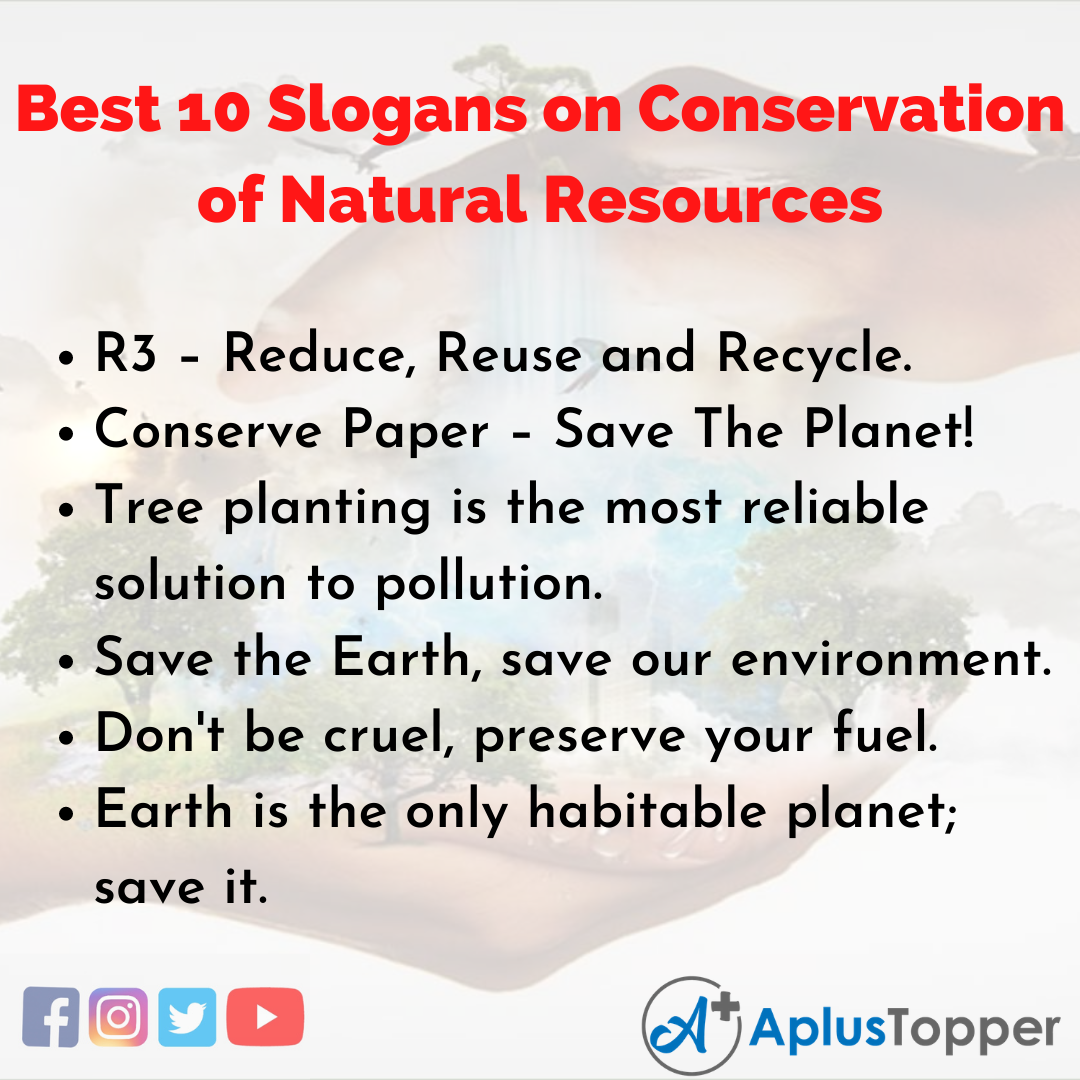Best 10 Slogans on Conservation of Natural Resources: Natural resources are often defined to be the resources that exist independent of human actions. These are the resources that are found within the environment and are developed without the intervention of humans. Common elements of natural resources include air, sunlight, water, plants, animals, and fossil fuels. The natural resources are of natural origin materials that are useful to man or might be useful under conceivable technological, economic or social situations or supplies drawn from our earth supplies like food, house and clothing, fertilizers, water, and geothermal power. For an extended time, natural resources were the domain of the natural sciences.
Students can read more Slogans about articles, events, people, sports, technology many more.
Best 10 Slogans on Conservation of Natural Resources in English
The four most vital Natural Resources are:
- Air: Clean air is vital for all the plants, animals, humans to survive on this planet. So it’s necessary to implement measures to cut back pollution.
- Water: 70% of the world filled with water, and only two parts of that’s freshwater. Initiative to educate and regulate the utilization of water should be taken.
- Soil: Soil consists of varied particles and nutrients. It helps plants grow.
- Forests: Forests provide clean air and preserve the ecology of the planet.
10 Unique and Catchy Slogans on Conservation of Natural Resources
1. R3 – Reduce, Reuse and Recycle.
2. Conserve Paper – Save The Planet!
3. Tree planting is the most reliable solution to pollution.
4. Save the Earth, save our environment.
5. Don’t be cruel, preserve your fuel.
6. Earth is the only habitable planet; save it.
7. Unite to make planet Earth pollution-free.
8. Pollution is our silent enemy; end it silently.
9. Prevent environmental health hazards.
10. Air pollution is the leading originator of several respiratory diseases.
Frequently Asked Questions on Best 10 Slogans on Conservation of Natural Resources
Question 1.
What are the other critical natural resources?
Answer:
Above mentioned are some of the world’s most critical natural resources. There are other natural resources which are also equally crucial for the survival of living organisms. Additional resources comprise mineral resources such as copper, gold, diamonds, energy resources such as gas, oil, uranium, and agricultural and logging land resources. All of these resources, in one way or another, play a role in the environment.
Question 2.
What are the applications of natural resources?
Answer:
Minerals, forest produce, water, and soil are just a few of the natural resources that human beings use to produce energy and make use of things. It is impossible to picture of our lives without these natural resources. For instance, a forest alone has multiple numbers of purposes that it serves. Within a few years or decades, specific natural resources can be replicated. These are referred to as renewable resources.
Question 3.
How do humans depend on natural resources?
Answer:
Living things need land, water, air, and energy, and they live in places with the things they need. These are the direct ways by which humans depend on natural resources. Apart from that, humans also depend indirectly on these resources. Like, forests provide a number of medicinal trees. Without these trees, several diseases in humans would be incurable. For all they do, humans utilize natural resources.
Question 4.
What are the features of natural resources?
Answer:
On Earth, it requires sunshine, air, water, land (including all minerals) along with all the plants, crops, and animal life that live naturally on or within the characteristics and substances previously identified. Few of these resources are renewable, while others are non-renewable. The renewable resources are sustainable, for example, air. Simultaneously, the non-renewable ones are exhaustible, like in the case of minerals and metals.
Question 5.
Does recycling conserve natural resources?
Answer:
By sustainability, recycling also conserves energy and natural reserves. We can conserve natural resources by utilizing materials more than once. Recycling saves trees and water in the case of paper. Growing up to 17 trees saves up to one ton of paper from recycled stock and uses 50 per cent less energy.
Question 6.
State the characteristics of renewable resources.
Answer:
It can be restored as it is available in infinite quantity, meaning the nature renews it. The next characteristic is that it is sustainable. It has a low cost and is also environment-friendly. When used, it replenishes quickly. However, it should not be abused and taken for granted. Often we don’t think twice before polluting these resources, which must stop.
Question 7.
State the characteristics of non-renewable resources.
Answer:
Once wholly consumed, it cannot be renewed due to limited stock. Therefore, it is exhaustible. Hence, it must be utilized extremely judiciously and cautiously. It has a high cost, and when compared to renewable resources, it is less environment-friendly. Non-renewable resources either replenish gradually or do not replenish naturally at all


